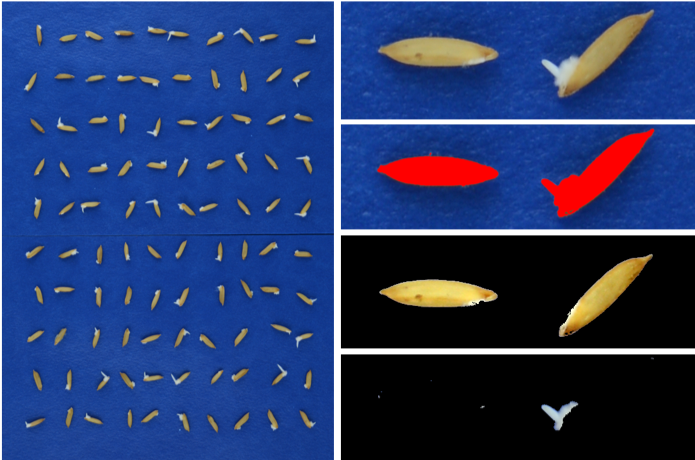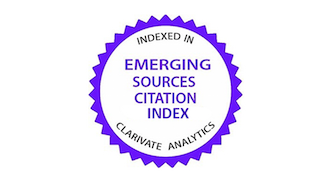Optimización del “Germinator” como complemento de análisis de calidad germinativa de semillas de arroz (Oryza sativa L.)
DOI:
https://doi.org/10.15517/am.v33iEspecial.50954Palabras clave:
calidad de semillas, vigor, fenotipado, envejecimiento acelerado, envejecimiento controladoResumen
Introducción. El uso de análisis de imágenes digitales con el “Germinator” permite evaluar la germinación de las semillas de forma automática. Además de la germinación máxima, se pueden cuantificar otros parámetros asociados al vigor de forma simultánea. Objetivo. Optimizar el “Germinator” como complemento de análisis automático de calidad germinativa de semillas de arroz. Materiales y métodos. Los experimentos se realizaron en el Centro para Investigaciones en Granos y Semillas (CIGRAS) durante el 2015 al 2018. Se optimizó el paquete de software denominado “Germinator” en la variedad Palmar 18 y después se probó con un panel de 126 muestras de semillas de arroz compuesta por catorce variedades. Se cuantificaron curvas de germinación, los datos obtenidos de forma automática se compararon con conteos manuales de protrusión radicular y con una metodología estandarizada. Además, se realizaron experimentos de envejecimiento acelerado y envejecimiento controlado para mostrar la sensibilidad del método automatizado. Resultados. La relación entre la germinación obtenida de forma automática y la cuantificada de forma manual fue alta (R2= 0,99). La germinación máxima, cuantificada por medio del análisis de imágenes varió de 69 % a 100 % en el panel de 126 muestras. La correlación entre la germinación evaluada mediante imágenes digitales y el método estándar fue de rho (spearman)= 0,34. El “Germinator” permitió cuantificar de forma simultánea otras variables asociadas con el vigor de las semillas, como el parámetro t50, que es el tiempo que la muestra de semillas toma para alcanzar el 50 % de la germinación. Además, el método automático reveló el efecto diferenciado de dos protocolos de envejecimiento. Conclusiones. El uso de análisis de imágenes en arroz permitió evaluar la germinación de forma automática basado en la protrusión radicular y también posibilitó cuantificar otras variables complementarias asociadas al vigor de la semilla (t50).
Descargas
Citas
AL-Tam, F., Adam, H., dos Anjos, A., Lorieux, M., Larmande, P., Ghesquière, A., Jouannic, S., & Shahbazkia, H. R. (2013). P-TRAP: A panicle trait phenotyping tool. BMC Plant Biology, 13(1), Article 122. https://doi.org/10.1186/1471-2229-13-122
Alvarez, J., Carbonell, V., Martinez, E., & Florez, M. (2019). The use of Peleg’s equation to model water absorption in triticale (x Triticosecale wittmack) seeds magnetically treated before soaking. Romanian Journal of Physics, 64, Article 810. https://rjp.nipne.ro/2019_64_3-4/RomJPhys.64.810.pdf
Carpenter, A. E., Jones, T. R., Lamprecht, M. R., Clarke, C., Kang, I. H., Friman, O., Guertin, D. A., Chang, J. H., Lindquist, R. A., Moffat, J., Golland, P., & Sabatini, D. M. (2006). CellProfiler: Image analysis software for identifying and quantifying cell phenotypes. Genome Biology, 7(10), Article R100. https://doi.org/10.1186/gb-2006-7-10-r100
Colmer, J., O’Neill, C. M., Wells, R., Bostrom, A., Reynolds, D., Websdale, D., Shiralagi, G., Lu, W., Lou, Q., Le Cornu, T., Ball, J., Renema, J., Flores Andaluz, G., Benjamins, R., Penfield, S., & Zhou, J. (2020). SeedGerm: A cost-effective phenotyping platform for automated seed imaging and machine-learning based phenotypic analysis of crop seed germination. New Phytologist, 228(2), 778–793. https://doi.org/10.1111/nph.16736
Dell’Aquila, A. (2004). Application of a computer-aided image analysis system to evaluate seed germination under different environmental conditions. Italian Journal of Agronomy, 8(1), 51–62. https://bit.ly/3RNmfrS
El-Kassaby, Y. A., Moss, I., Kolotelo, D., & Stoehr, M. (2008). Seed germination: mathematical representation and parameters extraction. Forest Science, 54(2), 220–227. https://doi.org/10.1093/forestscience/54.2.220
Ellis, R. H., & Roberts, E. H. (1980). Improved equations for the prediction of seed longevity. Annals of Botany, 45(1), 13–30. https://doi.org/10.1093/oxfordjournals.aob.a085797
ElMasry, G., ElGamal, R., Mandour, N., Gou, P., Al-Rejaie, S., Belin, E., & Rousseau, D. (2020). Emerging thermal imaging techniques for seed quality evaluation: Principles and applications. Food Research International, 131, Article 109025. https://doi.org/10.1016/j.foodres.2020.109025
Gehan, M. A., Fahlgren, N., Abbasi, A., Berry, J. C., Callen, S. T., Chavez, L., Doust, A. N., Feldman, M. J., Gilbert, K. B., Hodge, J. G., Hoyer, J. S., Lin, A., Liu, S., Lizárraga, C., Lorence, A., Miller, M., Platon, E., Tessman, M., & Sax, T. (2017). PlantCV v2: Image analysis software for high-throughput plant phenotyping. PeerJ, 5, Article e4088. https://doi.org/10.7717/peerj.4088
Hay, F. R., Adams, J., Manger, K., & Probert, R. (2008). The use of non-saturated lithium chloride solutions for experimental control of seed water content. Seed Science and Technology, 36(3), 737–746. https://doi.org/10.15258/sst.2008.36.3.23
International Seed Testing Association. (2018). International rules for seed testing. In International Seed Testing Association (Ed.), Seed vigour testing (2018 ed., pp. i15-1-i15-16). International Seed Testing Association.
International Seed Testing Association. (2022). International rules for seed testing. In International Seed Testing Association (Eds.), The germination test (2022 ed., pp. i5-1-i5.53). International Seed Testing Association.
Jimenez, J. A., Coyne, D. P., Anderson, F. N., & Pavlish, L. A. (1989). Imbibition of seed of dry bean cultivars stored under high or low temperature and relative humidity conditions. Scientia Horticulturae, 40(2), 91–98. https://doi.org/10.1016/0304-4238(89)90090-3
Joosen, R. V. L., Kodde, J., Willems, L. A. J., Ligterink, W., van der Plas, L. H. W., & Hilhorst, H. W. M. (2010). Germinator: A software package for high-throughput scoring and curve fitting of Arabidopsis seed germination. The Plant Journal, 62(1), 148–159. https://doi.org/10.1111/j.1365-313X.2009.04116.x
Kim, J. H., Kim, K. O., Lee, A. K., Roh, M. S., & Suh, J. K. (2017). Germination of Corylopsis seeds evaluated by X-ray imaging and cold stratification. Horticultural Science, 44(2), 105–111. https://doi.org/10.17221/194/2015-HORTSCI
Lurstwut, B., & Pornpanomchai, C. (2017). Image analysis based on color, shape and texture for rice seed (Oryza sativa L.) germination evaluation. Agriculture and Natural Resources, 51(5), 383–389. https://doi.org/10.1016/j.anres.2017.12.002
Moreno-Pizani, M. A., Farias-Ramirez, A. J., Thaner dos Santos,H., da Luz Coelho Novembre, A. D., Guevara-Orozco, L. I., Paredes-Trejo, F., Marin, F. R., da Silva Dias, N., & Alves Marques, P. A. (2019). Qualitative and quantitative evaluation protocol of Baccharis seed germination. Journal of Agricultural Science, 11(3), 421-434. https://doi.org/10.5539/jas.v11n3p421
Mussadiq, Z., Laszlo, B., Helyes, L., & Gyuricza, C. (2015). Evaluation and comparison of open source program solutions for automatic seed counting on digital images. Computers and Electronics in Agriculture, 117, 194–199. https://doi.org/10.1016/j.compag.2015.08.010
Newton, R., Hay, F., & Probert, R. (2009). Protocol for comparative seed longevity testing. [Technical Information Sheet 01]. Millenniun Seed Bank Project Kew. https://doi.org/10.13140/RG.2.2.23886.25921
Nguyen, G. N., & Norton, S. L. (2020). Genebank phenomics: A strategic approach to enhance value and utilization of crop germplasm. Plants, 9(7), Article 817. https://doi.org/10.3390/plants9070817
Oficina Nacional de Semillas. (2019). Estadísticas Comercialización y Producción de Semilla de Arroz. Programa de certificación de semilla de arroz. https://bit.ly/3U5HWoi
Oficina Nacional de Semillas. (2020). Características varietales de arroz (julio, 2020). Programa de certificación de semilla de arroz. https://bit.ly/3U4W2qa
Olesen, M. H., Duijn, B. van, & Boelt, B. (2014). Seed Testing International. In International Seed Testing Association (Eds.), Introduction of new methods: Spectral imaging (ISTA News Bulletin No. 147; pp.10-13) International Seed Testing Association.
Onwimol, D., Chanmprasert, W., Changsee, P., & Rongsangchaichareon, T. (2016). Seed vigor classification using analysis of mean radicle emergence time and single counts of radicle emergence in rice (Oryza sativa L.) and mung bean (Vigna radiata (L.) Wilczek). Agriculture and Natural Resources, 50(5), 345–350. https://doi.org/10.1016/j.anres.2016.12.003
Rajjou, L., Duval, M., Gallardo, K., Catusse, J., Bally, J., Job, C., & Job, D. (2012). Seed germination and vigor. Annual Review of Plant Biology, 63, 507–533. https://doi.org/10.1146/annurev-arplant-042811-105550
Schindelin, J., Arganda-Carreras, I., Frise, E., Kaynig, V., Longair, M., Pietzsch, T., Preibisch, S., Rueden, C., Saalfeld, S., Schmid, B., Tinevez, J. -Y., White, D. J., Hartenstein, V., Eliceiri, K., Tomancak, P., & Cardona, A. (2012). Fiji: An open-source platform for biological-image analysis. Nature Methods, 9(7), 676-682. https://doi.org/10.1038/nmeth.2019
Severini, A. D., Borrás, L., & Cirilo, A. G. (2011). Counting maize kernels through digital image analysis. Crop Science, 51(6), 2796–2800. https://doi.org/10.2135/cropsci2011.03.0147
Sun, Q., Wang, J., & Sun, B. (2007). Advances on seed vigor physiological and genetic mechanisms. Agricultural Sciences in China, 6(9), 1060–1066. https://doi.org/10.1016/S1671-2927(07)60147-3
Tanabata, T., Shibaya, T., Hori, K., Ebana, K., & Yano, M. (2012). SmartGrain: High-throughput phenotyping software for measuring seed shape through image analysis. Plant Physiology, 160(4), 1871–1880. https://doi.org/10.1104/pp.112.205120
Vidigal, D. S., Marques, A. C. S. S., Willems, L. A. J., Buijs, G., Méndez-Vigo, B., Hilhorst, H. W. M., Bentsink, L., Picó, F. X., & Alonso-Blanco, C. (2016). Altitudinal and climatic associations of seed dormancy and flowering traits evidence adaptation of annual life cycle timing in Arabidopsis thaliana. Plant, Cell & Environment, 39(8), 1737–1748. https://doi.org/10.1111/pce.12734
Wagner, M., Demilly, D., Ducournau, S., Dürr, C., & Léchappé, J. (2011). Computer vision for monitoring seed germination from dry state to young seedlings. Seed Test, 142, 49–51. https://www.seedtest.org/api/rm/G8F2GEQMB2N8K53/sti14249-51.pdf
Walters, C. (1998). Understanding the mechanisms and kinetics of seed aging. Seed Science Research, 8(2), 223–244. https://doi.org/10.1017/S096025850000413X
Wang, P., Fu, N., Li, D., & Wang, L. (2017). Predicting storage conditions for rice seed with thermodynamic analysis. International Journal of Food Engineering, 13(11), Article 20170129. https://doi.org/10.1515/ijfe-2017-0129
Watt, M., Fiorani, F., Usadel, B., Rascher, U., Muller, O., & Schurr, U. (2020). Phenotyping: New windows into the plant for breeders. Annual Review of Plant Biology, 71, 689–712. https://doi.org/10.1146/annurev-arplant-042916-041124
Whitehouse, K. J., Hay, F. R., & Ellis, R. H. (2015). Increases in the longevity of desiccation-phase developing rice seeds: Response to high-temperature drying depends on harvest moisture content. Annals of Botany, 116(2), 247–259. https://doi.org/10.1093/aob/mcv091
Wijesinghe, R. E. H., Lee, S. -Y., Kim, P., Jung, H. -Y., Jeon, M., & Kim, J. (2017). Optical sensing method to analyze germination rate of Capsicum annum seeds treated with growth-promoting chemical compounds using optical coherence tomography. Journal of Biomedical Optics, 22(9), Article 091502. https://doi.org/10.1117/1.JBO.22.9.091502
Yin, G., Whelan, J., Wu, S., Zhou, J., Chen, B., Chen, X., Zhang, J., He, J., Xin, X., & Lu, X. (2016). Comprehensive mitochondrial metabolic shift during the critical node of seed ageing in rice. PLOS ONE, 11(4), Article e0148013. https://doi.org/10.1371/journal.pone.0148013
Zerpa-Catanho, D., Hernández-Pridybailo, A., Madrigal-Ortiz, V., Zúñiga-Centeno, A., Porras-Martínez, C., Jiménez, V. M., & Barboza-Barquero, L. (2019). Seed germination of pitaya (Hylocereus spp.) as affected by seed extraction method, storage, germination conditions, germination assessment approach and water potential. Journal of Crop Improvement, 33(3), 372–394. https://doi.org/10.1080/15427528.2019.1604457

Archivos adicionales
Publicado
Cómo citar
Número
Sección
Licencia
1. Política propuesta para revistas de acceso abierto
Los autores/as que publiquen en esta revista aceptan las siguientes condiciones:
- Los autores/as conservan los derechos morales de autor y ceden a la revista el derecho de la primera publicación, con el trabajo registrado con la licencia de atribución, no comercial y sin obra derivada de Creative Commons, que permite a terceros utilizar lo publicado siempre que mencionen la autoría del trabajo y a la primera publicación en esta revista, no se puede hacer uso de la obra con propósitos comerciales y no se puede utilizar las publicaciones para remezclar, transformar o crear otra obra.
- Los autores/as pueden realizar otros acuerdos contractuales independientes y adicionales para la distribución no exclusiva de la versión del artículo publicado en esta revista (p. ej., incluirlo en un repositorio institucional o publicarlo en un libro) siempre que indiquen claramente que el trabajo se publicó por primera vez en esta revista.
- Se permite y recomienda a los autores/as a publicar su trabajo en Internet (por ejemplo en páginas institucionales o personales) antes y durante el proceso de revisión y publicación, ya que puede conducir a intercambios productivos y a una mayor y más rápida difusión del trabajo publicado (vea The Effect of Open Access).



























